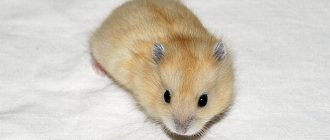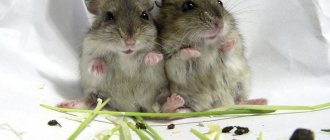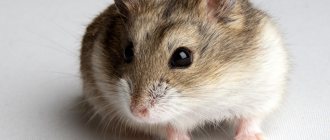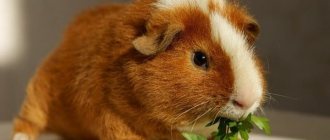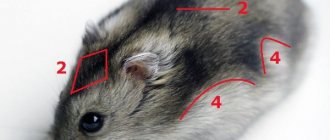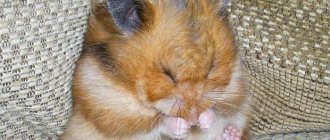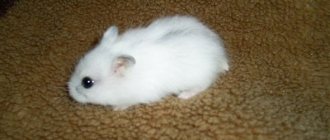Origin of the species and description
Photo: Syrian hamster
The Syrian hamster is a chordate animal. They are classified into the class of mammals, the order Rodents, the family Hamsters, the genus Medium hamsters, and the species Syrian hamsters. Initially, the name golden hamster was assigned to them thanks to zoologist Georg Robert Waterhouse. On the recommendation of Charles Darwin, he compiled a list of animals that arrived from the expedition on the Beagle. Among the diversity of representatives of the animal world, there was the only representative of this breed.
Video: Syrian hamster
This species of animal was first described by the English scientist, zoologist and researcher George Robert Waterhouse in 1839. The scientist mistakenly considered it an extinct species. This assumption was refuted in 1930, when another scientist Israel Aharoni, during his expedition, discovered a Syrian hamster - it was a pregnant female. The scientist transported this hamster to the University of Judea, where the female safely gave birth to 11 small hamsters. Subsequently, of the entire brood, only three males and the female who gave birth to them remained alive.
Scientists tried in vain to find other individuals of this species in natural conditions. However, they never managed to do this. Then Akhoroni came up with the idea of crossing a female Syrian hamster with a male of a related species. This couple became the progenitors of a new species. Around 1939-40, the resulting offspring were transported to the United States of America. After another 1.5-2 years, scientists finally came to the conclusion that the Central Asian hamsters had become extinct, and there were no more representatives of this species in natural conditions.
In the process of studying Syrian hamsters, it was found that they have a dental structure similar to that of humans, and therefore they were used in laboratory conditions to study dental diseases. To date, scientists have not been able to answer the question of what caused the extermination of this species of animals.
Appearance and features
Photo: Syrian hamster boy
Syrian or golden hamsters were bred in laboratory conditions from wild hamsters brought from Syria by zoologists in the last century. The body length of an adult is approximately 13-15 centimeters. Average body weight is 200-300 grams. This species is characterized by sexual dimorphism. Female individuals have a larger and stockier body. At the same time, the body length of females is slightly less than that of males. Another distinctive feature is the shape of the back. In females it is straight, in males it has a pointed shape. Individuals can also be recognized by the number of nipples. Females have four of them, males have only two.
Animals have a specific structure of their limbs. They have 4 toes on their forelimbs and five on their hind limbs. Most individuals of this species are golden in color, but individuals of other colors may occur.
What colors of Syrian hamsters can be found:
- copper;
- chocolate colors;
- sable;
- beige;
- honey;
- dark chocolate color.
The color may be uniform or have spots of a different color. The body of Central Asian hamsters is covered with thick and soft hair. Golden hamsters come in long-haired and short-haired varieties. The hamster's muzzle has a round, slightly elongated shape. There are small, rounded ears on the side of the head. The hamster's eyes are large, round, black, shiny. The nasal part of the animals is framed by whiskers. Hamsters have a small, short tail that is almost invisible in their thick fur.
Buying Syrian hamsters
Such an animal is sold in pet stores, through advertisements or on the market. At the same time, many who want to purchase a Central Asian hamster on the market should be warned, since there is no guarantee of purchasing a healthy animal.
Short-haired types of Syrian hamsters can cost around 300 rubles maximum, while long-haired types are more expensive and will have to pay up to 600 rubles for them.
Buying a Hamster New Pet Syrian Hamster First Day | Elli Di Pets
Where does the Syrian hamster live?
Photo: Syrian or golden hamster
Today, Syrian hamsters are not found in natural conditions. They exist exclusively in artificial conditions as pets. The founders of this species are wild hamsters, which were brought by a zoologist from Syria. This type of hamster has been purposefully bred in the United States. At the time of the existence of animals in natural conditions, they preferred to live in desert regions with a dry climate. The natural habitat of small rodents was quite wide.
Geographic regions where hamsters live:
- countries of Asia Minor;
- central regions of Africa;
- Southeast Asia;
- certain regions of the European continent;
- North America;
- South America.
Golden hamsters are considered not at all picky animals. They can adapt to living in almost any conditions: in steppes, forest-steppes, forests, even in mountainous areas. Some individuals lived in the mountains at an altitude of more than 2000 above sea level. Park areas, agricultural fields, orchards, and vegetable gardens were also not an exception. Small rodents choose small but deep burrows as their place of residence. It is worth noting that the hamsters chose those regions as their habitat that had enough food for the normal functioning of the animal.
How to feed and care for an animal
Features of keeping a rodent
Proper care of a Syrian hamster involves protecting the animal from stress. You cannot bring an animal and immediately put it on public display. Noises and a large number of new impressions can lead to illness. From fright, the baby may faint or bite its new owners.
He needs to be accustomed to hands and household members gradually.
Carefully place the animal in its new home and give it time to get used to it. An animal that feels insecure presses itself to the floor of the cage and moves slowly, looking around. If the animal has gotten used to it, it will quickly explore the house, run on a wheel and “dive” into the house.
How to care for a Syrian hamster
To provide a rodent with a decent life in your home, you need a cage or terrarium no smaller than 60x40 cm. It must be equipped with a house, a wheel, shelters, a feeder and water bowl, a toilet, a bath with sand and a mineral stone.
The floor should be covered with sawdust about 2 cm high so that the animal can dig holes.
The hamster prefers solitude. He cannot stand the proximity of his relatives.
The list of foods includes dry mixture, greens and protein products. You cannot feed your baby table scraps. a list of permitted and prohibited foods on the page dedicated to feeding the Syrian hamster.
"Syrians" are nocturnal animals. Their activity manifests itself in the evening and at night. This must be taken into account when choosing a location for the cage. Don't put it in the bedroom, it will be noisy at night.
Do not wake up the animals during the daytime - this is very stressful for them.
The smell in the cage appears if the animal is not kept properly or the cage is rarely cleaned. Depending on the size of the animal’s home, the procedure is carried out from once every 3 days to once a week. When cleaning, remove spoiled food from your pet's supplies. Change the water in the drinking bowl daily.
Do not leave your pet unattended while walking in open spaces.
The Syrian hamster is a lowland animal. The difference in height is dangerous for him. The animal easily steps into the void and injures itself when falling from a table or from a window.
Bathing hamsters is not allowed
Proper care for Syrian hamsters does not include water treatments. This desert animal does an excellent job of cleaning its skin on its own. To clean his fur coat, give him a tray with sand. Some animals enjoy rolling around in it.
How far can animals run?
An experiment was conducted to see how much hamsters run during the night. It turned out that the baby covers a distance of 6-7 km with an average speed of 2 km/h. In nature, this furry animal is capable of conquering distances of up to 12 km.
Another experiment involved running in a wheel. It turned out that during the night the animal ran from 6 to 10 km, with a maximum speed reaching 3.6 km/h.
Due to the high activity of the animal, it is necessary to purchase a running wheel or walking ball.
What does the Syrian hamster eat?
Photo: Syrian hamsters
Syrian hamsters are considered almost omnivorous animals. The source of nutrition can be either plant food or food of animal origin. As a last resort, rodents eat larvae, ants, small bugs, etc. Hamsters living in natural conditions eat almost anything they can find and eat. These can be seeds, roots of various types of vegetation, berries, juicy fruits, herbs, etc.
Interesting fact: Science knows of cases where golden hamsters living in natural conditions ate their cubs.
If an animal is kept at home, it is important to understand that human food is completely unsuitable for it. A person whose home contains a small fluffy rodent must become familiar with the rules and feeding habits of the animal, as well as avoid overfeeding and ensure a balanced diet. It is strictly forbidden to feed hamsters sweet, salty or fatty foods. Despite the fact that these little animals simply love sweets, their digestive system is not able to digest such foods. This can cause the death of the animal.
The basis of a pet hamster's diet should be dry, balanced food. It is easy to purchase at any zoological supply store. The dry mixture must contain vitamins and minerals, and must also be intended exclusively for hamsters, and not for any other animals or birds. However, you shouldn’t limit yourself to dry food only. In order for the animal to be active and healthy, it will also need wet food.
What can you give hamsters as wet food:
- greenery;
- lettuce leaves;
- fruits;
- vegetables;
- berries;
- carrot;
- zucchini.
In small quantities, you can add dried fruits to your diet and always low-fat cottage cheese without any additives. When keeping at home, care must be taken to ensure that the animal always has clean water available for drinking.
Now you know what you can give Syrian hamsters at home and what not. Let's see how golden hamsters behave in their natural environment.
Diet
Siberian hamsters feed in the morning and evening. The animal should not be fed more often, otherwise it may have digestive problems. Most of all, the animals will like the vitamin mixture, which includes plant products such as corn, buckwheat, oats and seeds. This is what should form the basis of his diet.
When introducing new products, do so gradually. Be sure to pamper your pet with some treats:
- herbs: parsley and dill;
- fresh vegetables: carrots, beets, zucchini;
- dried fruits: apple, pear or apricot;
- clover, plantain or dandelion.
Siberian hamsters love to eat grapes, bananas, cauliflower and broccoli raw. It is equally important that your rodent’s diet includes protein foods. There are foods that are strictly prohibited from being included in the diet of birds. These are sweets, especially chocolate and baked cookies, pickles and smoked meats, bakery and dairy products, cabbage. Don’t forget about water - it must be refreshed every day.
Features of character and lifestyle
Photo: Syrian hamster girl
The golden or Syrian hamster is considered a nocturnal animal. He sleeps almost all day, waking up only to satisfy his hunger. But at night he wakes up and becomes very energetic. In natural conditions, hamsters constantly dig the ground. They are able to dig an almost unlimited number of earthen passages and holes. Hamsters tend to lead an isolated lifestyle. Each individual needs its own home. This should be taken into account when keeping animals at home. Rodents tend to store food. They put food in their cheek, then take it out and eat it.
Interesting fact: The cheek space in which hamsters store food can hold a volume of food that is almost three times the size of the animal’s head. The small rodent itself is capable of storing up to 13-15 kilograms of food, which can exceed its own body weight by 100 times!
With the onset of darkness, incredible animal activity is observed. In natural conditions, this helped them escape from numerous enemies. At night, the animals are engaged in arranging their homes, preparing food supplies and consuming them, and can also simply frolic and play. In natural conditions, hamsters tended to lead an isolated, rather solitary lifestyle. Juveniles could sometimes form small groups. Having reached sexual maturity, hamsters begin to fight for territory, food supply, etc. Often such disputes end in death for weaker individuals.
To keep it at home, a small rodent will need a spacious cage with an equipped sleeping area and a house. It is desirable that the cages have a carousel and a ladder in several tiers. In conditions of limited space, this is an indispensable attribute for the animal’s comfortable living.
Owner reviews
Syrian hamsters are characterized by having a sociable and friendly character, so they prefer to be in constant contact with their owner.
Such a pet requires constant care, as well as unobtrusive love, since excessive attention can lead the animal to stress, and subsequently to the manifestation of a number of ailments that are difficult to deal with.
Important point! According to many experienced owners, it is enough for Syrian hamsters if you handle them no more than 3 times a day, for 15 minutes, no more.
These animals, despite their mobility and curiosity, are mainly active in the dark. It follows from this that it is better to choose evening hours to communicate with your pet.
Syrian hamsters, due to their ease of care and maintenance, are very popular. They are typically one of the first pets children encounter. Since this animal does not require special care and maintenance, and its character is quite friendly and flexible, all family members and especially children quickly become attached to this pet.
Social structure and reproduction
Photo: Syrian hamster
Golden hamsters are very prolific animals, provided they are kept in optimal, comfortable conditions. If the temperature of the space surrounding them is maintained at 20-25 degrees, animals will be able to bear offspring almost all year round. Most often, with good care, a sexually mature female individual bears offspring 3-5 times a year. She can give birth to 5 to 9 babies at the same time.
The period of sexual maturity in males occurs at the age of one month, and in females at the age of two months. It is recommended to breed animals to produce offspring after the female has gone into estrus. Otherwise, individuals can seriously fight, even causing injury to each other. If the hamsters like each other, then they mate successfully. The whole process lasts no more than 10 minutes. Pregnancy may not occur the first time. Then a second mating will be required.
Pregnancy lasts on average 17-18 days. When the time comes to give birth, the female goes into the nest or shelter she has made. The mother feeds newborn babies with milk for another month. After the male has impregnated the female, they must be separated, since pregnant females are characterized by aggressive behavior towards their relatives. The owner should also be careful, since during this period the animals tend to bite.
Breeding
Golden hamsters are highly fertile. These rodents are capable of producing 3-5 litters per year. The female Syrian hamster is ready to reproduce from the age of 4 months. The male becomes sexually mature at 3 months.
For successful fertilization, a boy and a girl are placed in a spacious cage and live there for some time. After mating, the animals are resettled, since pregnant females become very aggressive.
After 18 days from the moment of fertilization, from 4 to 15 cubs are born. Until 30 days of age, babies feed exclusively on mother's milk, and at approximately 37 days they can already be moved to another cage.
Important! It is advisable to place the cage with the mother and offspring in a quiet, dark place. And the newborns themselves should not be touched with your hands. Otherwise, the female will pick up the alien scent and may eat the cubs.
Syrian hamsters are charming rodents with a pleasant appearance and a sociable, playful disposition. They are not picky in their diet and do not require complex care. If treated correctly, cute animals will become an inexhaustible source of positivity.
Natural enemies of Syrian hamsters
Photo: Syrian hamster
Under natural conditions, Syrian hamsters have a large number of enemies, for whom small rodents are easy prey. Their nocturnal lifestyle helped them escape from some predators, but many, like rodents, were nocturnal.
Enemies of golden hamsters in the wild:
- large forest predators - fox, wolf, lynx, etc. They can wait for hamsters, chase, or look for their holes;
- predatory bird species - hawks, falcons, owls. The most dangerous for the Syrian hamster were owls, since they are characterized by a nocturnal lifestyle;
- cats, dogs.
Hamsters are naturally endowed with very acute hearing. It allows you to pick up the slightest sound vibrations at a considerable distance. This allows you to sense the enemy's approach. If an animal hears unfamiliar sounds, it immediately flees and hides in a hole or other reliable shelter. When unfamiliar sounds are heard at a short distance, and there is no way to escape, the animal freezes in the hope of remaining unseen. If this technique does not help, the small rodent attacks its enemy. In some cases, a sudden attack by a hamster frightens even such a large predator as a fox or lynx. However, it will not be possible to escape from the birds in this way.
Main diseases of Syrians and their prevention
Syrian hamsters very rarely get sick. To minimize the risk of disease, you need to buy them from a registered breeder and keep them properly. Regular checks with a veterinarian are sufficient prevention for them. And yet, Syrians can sometimes get sick.
Let us highlight the main signs of deteriorating health in a hamster. If you notice them, take your pet to the veterinarian for an examination. Home treatment is not the best option.
So, the signs you should pay attention to:
- lack of appetite, strong pickiness in choosing foods;
- increased secretion of saliva, wet fur from below the muzzle;
- digestive disorders: liquid, dry or hard feces;
- tearfulness or purulent discharge covering the eyelids;
- respiratory tract diseases: wheezing, wheezing;
- deterioration of the coat: hair loss, wounds, scratching;
- reluctance to be physically active
- trembling, convulsions, loss of coordination;
- unnatural formations on the hamster's body.

